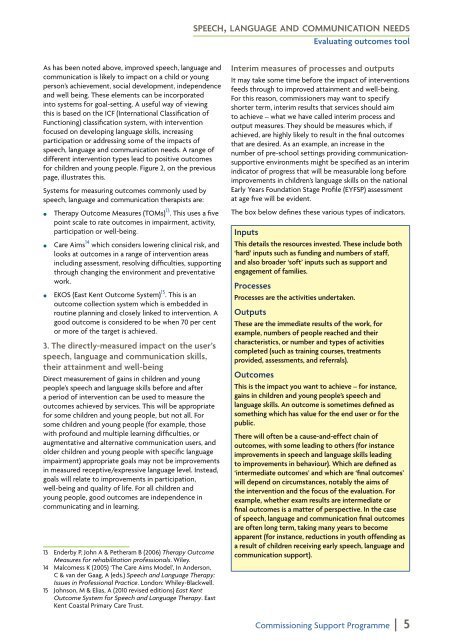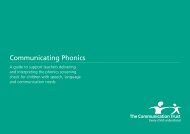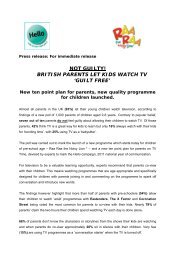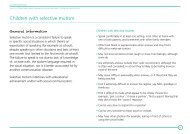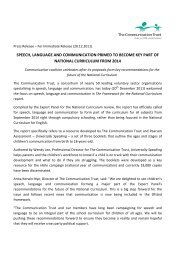Speech, language and communication needs: Evaluating outcomes ...
Speech, language and communication needs: Evaluating outcomes ...
Speech, language and communication needs: Evaluating outcomes ...
Create successful ePaper yourself
Turn your PDF publications into a flip-book with our unique Google optimized e-Paper software.
speech, <strong>language</strong> <strong>and</strong> <strong>communication</strong> <strong>needs</strong><br />
<strong>Evaluating</strong> <strong>outcomes</strong> tool<br />
As has been noted above, improved speech, <strong>language</strong> <strong>and</strong><br />
<strong>communication</strong> is likely to impact on a child or young<br />
person’s achievement, social development, independence<br />
<strong>and</strong> well being. These elements can be incorporated<br />
into systems for goal-setting. A useful way of viewing<br />
this is based on the ICF (International Classification of<br />
Functioning) classification system, with intervention<br />
focused on developing <strong>language</strong> skills, increasing<br />
participation or addressing some of the impacts of<br />
speech, <strong>language</strong> <strong>and</strong> <strong>communication</strong> <strong>needs</strong>. A range of<br />
different intervention types lead to positive <strong>outcomes</strong><br />
for children <strong>and</strong> young people. Figure 2, on the previous<br />
page, illustrates this.<br />
Systems for measuring <strong>outcomes</strong> commonly used by<br />
speech, <strong>language</strong> <strong>and</strong> <strong>communication</strong> therapists are:<br />
• Therapy Outcome Measures (TOMs) 13 . This uses a five<br />
point scale to rate <strong>outcomes</strong> in impairment, activity,<br />
participation or well-being.<br />
• Care Aims 14 which considers lowering clinical risk, <strong>and</strong><br />
looks at <strong>outcomes</strong> in a range of intervention areas<br />
including assessment, resolving difficulties, supporting<br />
through changing the environment <strong>and</strong> preventative<br />
work.<br />
• EKOS (East Kent Outcome System) 15 . This is an<br />
outcome collection system which is embedded in<br />
routine planning <strong>and</strong> closely linked to intervention. A<br />
good outcome is considered to be when 70 per cent<br />
or more of the target is achieved.<br />
3. The directly-measured impact on the user’s<br />
speech, <strong>language</strong> <strong>and</strong> <strong>communication</strong> skills,<br />
their attainment <strong>and</strong> well-being<br />
Direct measurement of gains in children <strong>and</strong> young<br />
people’s speech <strong>and</strong> <strong>language</strong> skills before <strong>and</strong> after<br />
a period of intervention can be used to measure the<br />
<strong>outcomes</strong> achieved by services. This will be appropriate<br />
for some children <strong>and</strong> young people, but not all. For<br />
some children <strong>and</strong> young people (for example, those<br />
with profound <strong>and</strong> multiple learning difficulties, or<br />
augmentative <strong>and</strong> alternative <strong>communication</strong> users, <strong>and</strong><br />
older children <strong>and</strong> young people with specific <strong>language</strong><br />
impairment) appropriate goals may not be improvements<br />
in measured receptive/expressive <strong>language</strong> level. Instead,<br />
goals will relate to improvements in participation,<br />
well-being <strong>and</strong> quality of life. For all children <strong>and</strong><br />
young people, good <strong>outcomes</strong> are independence in<br />
communicating <strong>and</strong> in learning.<br />
13 Enderby P, John A & Petheram B (2006) Therapy Outcome<br />
Measures for rehabilitation professionals. Wiley.<br />
14 Malcomess K (2005) ‘The Care Aims Model’, In Anderson,<br />
C & van der Gaag, A (eds.) <strong>Speech</strong> <strong>and</strong> Language Therapy:<br />
Issues in Professional Practice. London: Whiley-Blackwell.<br />
15 Johnson, M & Elias, A (2010 revised editions) East Kent<br />
Outcome System for <strong>Speech</strong> <strong>and</strong> Language Therapy. East<br />
Kent Coastal Primary Care Trust.<br />
Interim measures of processes <strong>and</strong> outputs<br />
It may take some time before the impact of interventions<br />
feeds through to improved attainment <strong>and</strong> well-being.<br />
For this reason, commissioners may want to specify<br />
shorter term, interim results that services should aim<br />
to achieve – what we have called interim process <strong>and</strong><br />
output measures. They should be measures which, if<br />
achieved, are highly likely to result in the final <strong>outcomes</strong><br />
that are desired. As an example, an increase in the<br />
number of pre-school settings providing <strong>communication</strong>supportive<br />
environments might be specified as an interim<br />
indicator of progress that will be measurable long before<br />
improvements in children’s <strong>language</strong> skills on the national<br />
Early Years Foundation Stage Profile (EYFSP) assessment<br />
at age five will be evident.<br />
The box below defines these various types of indicators.<br />
Inputs<br />
This details the resources invested. These include both<br />
‘hard’ inputs such as funding <strong>and</strong> numbers of staff,<br />
<strong>and</strong> also broader ‘soft’ inputs such as support <strong>and</strong><br />
engagement of families.<br />
Processes<br />
Processes are the activities undertaken.<br />
Outputs<br />
These are the immediate results of the work, for<br />
example, numbers of people reached <strong>and</strong> their<br />
characteristics, or number <strong>and</strong> types of activities<br />
completed (such as training courses, treatments<br />
provided, assessments, <strong>and</strong> referrals).<br />
Outcomes<br />
This is the impact you want to achieve – for instance,<br />
gains in children <strong>and</strong> young people’s speech <strong>and</strong><br />
<strong>language</strong> skills. An outcome is sometimes defined as<br />
something which has value for the end user or for the<br />
public.<br />
There will often be a cause-<strong>and</strong>-effect chain of<br />
<strong>outcomes</strong>, with some leading to others (for instance<br />
improvements in speech <strong>and</strong> <strong>language</strong> skills leading<br />
to improvements in behaviour). Which are defined as<br />
‘intermediate <strong>outcomes</strong>’ <strong>and</strong> which are ‘final <strong>outcomes</strong>’<br />
will depend on circumstances, notably the aims of<br />
the intervention <strong>and</strong> the focus of the evaluation. For<br />
example, whether exam results are intermediate or<br />
final <strong>outcomes</strong> is a matter of perspective. In the case<br />
of speech, <strong>language</strong> <strong>and</strong> <strong>communication</strong> final <strong>outcomes</strong><br />
are often long term, taking many years to become<br />
apparent (for instance, reductions in youth offending as<br />
a result of children receiving early speech, <strong>language</strong> <strong>and</strong><br />
<strong>communication</strong> support).<br />
Commissioning Support Programme | 5


